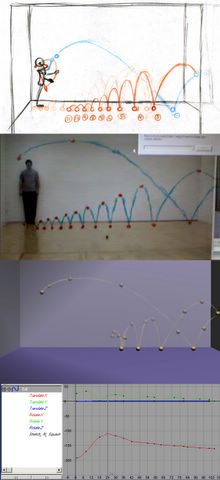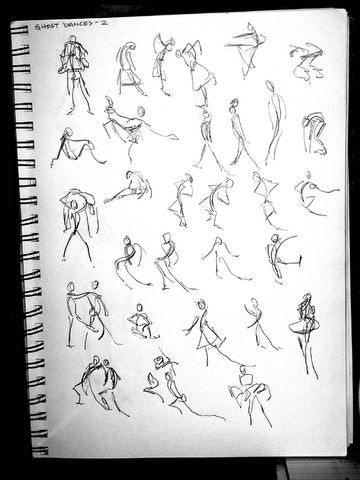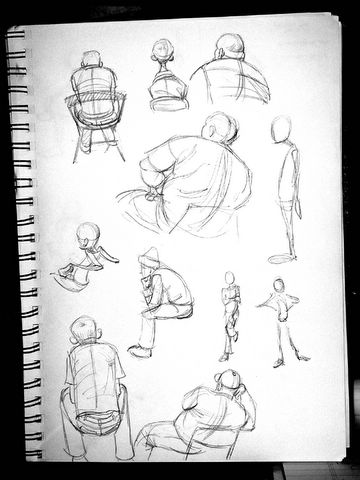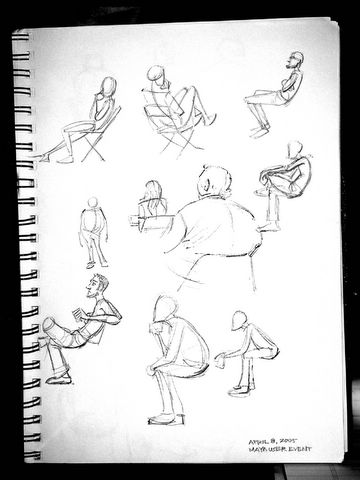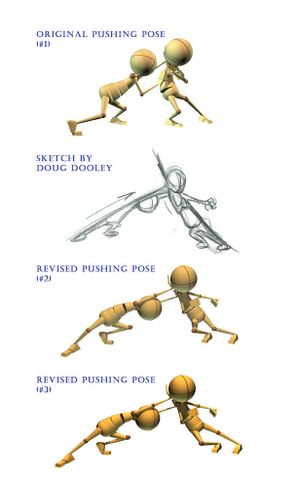Week 5: Obstacle Course

Planning, planning, planning...
Well, apparently the best way to get critiques from fellow students and campus mentors is to post a thread in the critique forums. That's where everybody seems to be going these days. I'm finding that not many students are online. I don't know if it's a technical glitch, where they are really there and I just can't see them for some reason or what.
Anyhow, I posted this planning sketch to get feedback before I started on it, and Doug Dooley from Pixar (he also helped me out on my "Push Pose" from a few weeks ago) responded. Basically he said that when he started at Pixar, they gave him a very simple bouncing ball to animate in order to learn their software. Piece of cake? Well, they worked with him on it for 2 days, getting it just right. So, while he liked the ambition and enthusiasm of my idea, he encouraged me to use my creativity in less complicated ways for now. Not to lose it, but to really get the basics down before trying to tackle a challenging set-up like this. He said if he were to do this setup and do it RIGHT, it would take a while...hell, I'll just go ahead and post his entire reply:
Hey Kenshi,
Dude, you got the enthusiasm no doubt! Now, this is just my opinion, but I've seen students get really hurt by ambitious plans. I know you'll put the energy into it, and ball bounces can be really boring, but if you go that crazy with it, you may lose out on really learning the details of what makes ball bounces a %100 believable.
My first day at Pixar, they gave me a ball bounce to do to learn the software. I think "hey, I'm not the best, but I've been doing this for a while, I can do a ball bounce in my sleep. Dude they had me working on those 3 straight ahead ball bounces for 2 days trying to get all the right characteristics in each ball. Not that we have time in production to spend 2 days on a ball bounce, but it proves how much detail can go into a bounce to really get it right.
There is a lot to learn in this exercise thats boring, but if you get caught up with something this elaborate you may not get it just right. Studios will be more impressed with a reel that has a little animation perfect, than a lot of animation imperfect. Don't lose your imagination, just use it to come up with a simple imaginative thing.
I snuck a peek at your first ball bounce, and it was definitely good, but I think there was room for a bit of fine tuning. I really want to see you develope into a really good animator, so be careful to really learn the basics before you bite off something that big. If I was given your current plan to animate, I think I could eventually get right, with the help of people at work, but it would be really hard. I don't think you could get that in the required frame range either.
This definitely comes down to an opinion thing, but I've seen so many students drown in complicated projects, that I want you to at least realize what can happen.
Keep up the good work! It was a cool idea!
dooley
I guess my eyes are a little bit bigger than my stomach sometimes. So yeah, Doug's response was humbling to say the least. Not that I'm discouraged by what he said at all. It's actually quite a relief. I had been putting some pressure on myself to have the most creative ideas and do the most challenging things possible, but I don't need to be doing that. Confidence will come from learning the baby steps and just NAILING all of the basic principles of animation: timing, spacing, arcs, ease in and ease out, squash and stretch, anticipation.
When I critique fellow student's work, I am learning to critique the strengths and weaknesses of the work in terms of those principles: "I think the timing is right, but the spacing feels off..." I'm starting the think in terms of the principles. It really helps when it comes to seeing the bigger picture and being able to break down movement (a very complex thing) into parts you can break down and talk about in a way that makes sense.
I'm also learning that my sense of posing is probably my biggest strength at this point. Sure, on a certain level everything is subjective, but when it comes to the human body, it's much easier for me to pick out what's not working than on stuff like bouncing balls. Which only means I need to spend more time observing balls if I'm going to know how to make them move convincingly.




